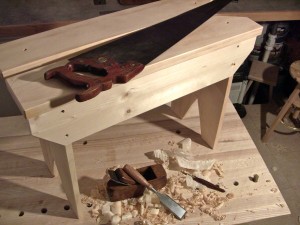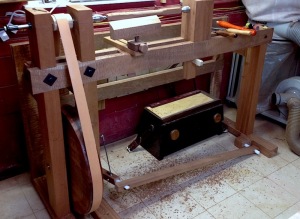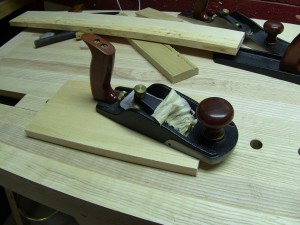On the Merits of Planned Obsolescence
“Buy your last tool first!”
“Overbuild it just in case”
These are common sentiments we find in our little woodworking world. Some days I agree with them wholeheartedly, then the rest of the time I ignore them on purpose. That purpose may be laziness, but I prefer to think of it as a learning experience. How can you know what you need in a tool or a workbench or whatever until you have spent some time working with/on it to understand its shortcomings. Sometimes planning for your bench or tool or whatever to fail on you in the future can be the best way to move forward. Stay with me here and I’ll share some examples on different points of the spectrum.
The Little Bench that Could
 I built a saw bench back in 2010. It was a project for The Hand Tool School specifically mean to apply some hand sawing skills taught in a lesson on sawing. I designed the bench to be made using only a saw with home center lumber. I wanted the students to focus on the sawing and not get caught up in planing boards but also as an exercise in letting the saw correct issues that may crop up with boards that are slightly cupped. There are hundreds of other ways this bench could have been built that would have resulted in a more durable and functional design. But its a saw bench that will most likely get sawn into over time and like a push block at a table saw will eventually need to be replaced. That time has come for me and my well worn saw bench has gotten rickety and has more saw kerfs in it that the aforementioned push block.
I built a saw bench back in 2010. It was a project for The Hand Tool School specifically mean to apply some hand sawing skills taught in a lesson on sawing. I designed the bench to be made using only a saw with home center lumber. I wanted the students to focus on the sawing and not get caught up in planing boards but also as an exercise in letting the saw correct issues that may crop up with boards that are slightly cupped. There are hundreds of other ways this bench could have been built that would have resulted in a more durable and functional design. But its a saw bench that will most likely get sawn into over time and like a push block at a table saw will eventually need to be replaced. That time has come for me and my well worn saw bench has gotten rickety and has more saw kerfs in it that the aforementioned push block.
I knew full well that I could have built that bench to be more durable but the intended lesson to be learned would have been masked with other details. Plus now that I have been using it for 5 years I have some very keen ideas on how I will design my next saw bench. Still I have to wonder if I will design my next saw bench to be my last or if I will just embrace the obsolescence and cobble together another one so I can keep working. I’m sure the next one will be better but maybe this time I’ll build it so the top can be easily replaced while keeping a strong sub structure. Then again, maybe I’ll try to teach myself something else with this next saw bench and build it using nothing but strange Japanese temple joints and a saw that cuts backwards. Who knows, but it should be fun no matter what I do. Just planning on replacing it later gives me some freedom to try something new and the hell with the consequences of failure. Planned obsolescence in this case builds my skills and opens the door for innovation in a design.
There Can Be Only One…Treadle Lathe
 On the opposite end of things is my treadle lathe. I started hypothesizing a design for a flywheel lathe back in 2008. I finally built one in 2014 after analyzing it to death and turning on many different designs whenever I found one in the wild. The result? A pretty awesome machine that could turn anything from table legs to giant, 16″ diameter bowls. If needed, I can turn on the outboard side of the headstock and turn massive table tops or just set the grinder attachment in place to use my Tormek jigs. So what is the downside here? Simply put, I overbuilt it. I don’t need the capacity I have with this machine. I rarely turn bowls and when I do 8″ is about as big as I go. I do turn table legs but this lathe will give me a table leg plus room for a footstool at the same time! The tool rack built in to the back adds mass which is nice but its entirely non functional as it requires me to reach across the spinning workpiece to reach a tool. Not a safe idea so I have to stop turning entirely when I change tools. One thing about flywheel lathes is they don’t require much effort to turn at 1000 rpms. The effort comes in getting up to speed and despite it only taking a few seconds, it is annoying to stop and start when you just needed that one tool for a few seconds.
On the opposite end of things is my treadle lathe. I started hypothesizing a design for a flywheel lathe back in 2008. I finally built one in 2014 after analyzing it to death and turning on many different designs whenever I found one in the wild. The result? A pretty awesome machine that could turn anything from table legs to giant, 16″ diameter bowls. If needed, I can turn on the outboard side of the headstock and turn massive table tops or just set the grinder attachment in place to use my Tormek jigs. So what is the downside here? Simply put, I overbuilt it. I don’t need the capacity I have with this machine. I rarely turn bowls and when I do 8″ is about as big as I go. I do turn table legs but this lathe will give me a table leg plus room for a footstool at the same time! The tool rack built in to the back adds mass which is nice but its entirely non functional as it requires me to reach across the spinning workpiece to reach a tool. Not a safe idea so I have to stop turning entirely when I change tools. One thing about flywheel lathes is they don’t require much effort to turn at 1000 rpms. The effort comes in getting up to speed and despite it only taking a few seconds, it is annoying to stop and start when you just needed that one tool for a few seconds.
Don’t get me wrong, this lathe is awesome but 8 months on after building it I realize just how much space it took up and how much of that space wasn’t being used with my typical turning projects. After all the years of analyzing and aiming to build the ultimate treadle lathe that would be able to handle any possible turning scenario I hadn’t stopped to think whether I needed it to do all that. Frankly I pretty proud of that lathe but I replaced it with a more compact Barnes lathe that I could move around and doesn’t dominate one entire wall of my shop.
In this instance I designed something that would never become obsolete and in doing so ended up with a machine that doesn’t suit my space or my work. I also learned that I sincerely enjoy turning on a pole lathe and now spend more time on my reciprocal lathes. For now the lathe is disassembled until a future time when I can afford the dedicated space. Perhaps I should have cobbled something together like my saw bench.
A Smoother to Tackle the Gnarliest of Woods
 All of the above center around things I designed and built myself. What about buying with obsolescence in mind? I do believe that if you buy a high quality tool it will always have a place in your shop, but being realistic about what you actually need is important in that buying decision. For instance early on in my hand tool obsession I decided to buy a premium smoothing place. I researched all the things that make a smoother great and what was needed to tackle difficult woods and landed on a Veritas Bevel Up Smoother with extra 38 and 50 degree blades. This plane is a beast and when sharp and set up right, you can plane directly against the grain without tear out. But the funny thing is, rarely do I actually work with ornery grained wood. I like North American domestics in nice straight grained boards. Not just because they are easier to plane but just because I personally like the honesty of a straight grain over heavy figure. So now I do 99% of my smoothing with a typical #4 plane. Granted it is a Lie Nielsen and very high quality but it doesn’t have any of the other bells and whistles and is essentially a replica of a vintage Stanley. Just in new condition with modern steel and castings. My Veritas plane won’t every go anywhere because it does its job really well, but it also isn’t needed that much because of the woods I choose to use. Once again my analyzing and planning to get a tool that would never become obsolete left me with overkill that now spends its life on the bench waiting for that bottom of the ninth, based loaded, closer duty. (Go Orioles!)
All of the above center around things I designed and built myself. What about buying with obsolescence in mind? I do believe that if you buy a high quality tool it will always have a place in your shop, but being realistic about what you actually need is important in that buying decision. For instance early on in my hand tool obsession I decided to buy a premium smoothing place. I researched all the things that make a smoother great and what was needed to tackle difficult woods and landed on a Veritas Bevel Up Smoother with extra 38 and 50 degree blades. This plane is a beast and when sharp and set up right, you can plane directly against the grain without tear out. But the funny thing is, rarely do I actually work with ornery grained wood. I like North American domestics in nice straight grained boards. Not just because they are easier to plane but just because I personally like the honesty of a straight grain over heavy figure. So now I do 99% of my smoothing with a typical #4 plane. Granted it is a Lie Nielsen and very high quality but it doesn’t have any of the other bells and whistles and is essentially a replica of a vintage Stanley. Just in new condition with modern steel and castings. My Veritas plane won’t every go anywhere because it does its job really well, but it also isn’t needed that much because of the woods I choose to use. Once again my analyzing and planning to get a tool that would never become obsolete left me with overkill that now spends its life on the bench waiting for that bottom of the ninth, based loaded, closer duty. (Go Orioles!)
Obviously I’m choosing some very select examples and I could think of other examples where buying the last tool first was a good idea. Interestingly enough those examples are from later in my “career” as a woodworker where I was a lot better informed on what I needed.
So by all means, buy your last tool first…after you have used some other ones for a few years. Just call those experiments.


